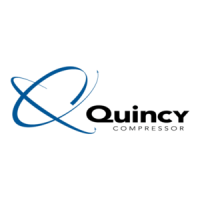Section IV - Installation
1) Location:
Locate the vacuum pump on a level surface that is clean, well lit, well ventilated and
capable taking the weight of the pump. The entire length of the frame base must be
supported. Shim where necessary (do not use wood).
Ambient temperature should not exceed temperatures listed on the specifications.
All models are intended for indoor installation.
Do not locate the unit where the hot exhaust air from other vacuum pumps or heat
generating equipment may be drawn into the unit. Never restrict the flow of exhaust air
from the fluid cooler.
The heated exhaust air must be exhausted to the outside to prevent high ambient
conditions in the room.
2) Piping connections:
The vacuum distribution and piping system, including the vacuum pump and all related
components, must be designed in accordance with generally accepted engineering
practices. For instance, inlet pipe work should slope away from the vacuum pump.
Improperly designed distribution systems can cause damage to the vacuum pump.
Exhaust piping should be installed in such a manner as to not create additional back
pressure on the vacuum pump. Also, the exhaust piping should be installed sloping away
from the vacuum pump.
A drip leg with drain point provision is foreseen available inside the vacuum pump, to
prevent condensate from running back into the fluid reservoir.
Care must be taken to avoid assembling the piping in a strain with the vacuum pump.
It is very important to use adequate pipe diameter for the vacuum network. The
combination of restrictive pipe diameter and long pipe runs can create significant
pressure drop. A rule of thumb on single vacuum pump installations: maintain the
diameter of the vacuum pump inlet as far into the process as possible.
It is recommended to install an isolation valve at the inlet of the vacuum pump, to isolate
the pump from vacuum distrubution and piping system before performing maintenance.
The discharge air can run up to 120 °C (248 °F), piping should be suitable to handle this
temperature.
3) Ventilation:
The inlet grid(s) and ventillation fan should be installed in such a way that any
recirculation of cooling air to the inlet grating of the vacuum pump is avoided. The air
velocity to the grid(s) has to be limited to 5m/s.
The maximum air temperature at intake opening is 46 °C (115 °F), ( minimum 0 °C / 32
°F ) Ventilation alternative 1 and 3 : The required ventilation to limit vacuum pump room
temperature can be calculated from :
Qv = 1.06 N / T
Where,
Qv = Required cooling air ow (m³/s)
N = Nominal motor power of vacuum pump (kW)
T = Temperature increase in vacuum pump room. ( °C)
Ventilation alternative 2 and 4 : The fan capacity should match the vacuum pump- fan
capacity at a pressure head
equal to the pressure drop caused by cooling air ducts.
Max. allowable pressure drop in ducting before or after the vacuum pump = 10 Pa
Quincy Vacuum Pump-QSV Series 65

